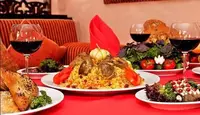East

Cooking in the East has been elevated to the rank of religion: some foods are its obligatory attributes, while certain animals are considered "unclean" or, conversely, sacred, but in both cases their use as food is prohibited. These characteristics, along with huge territories, a large variety of seafood, as well as exotic fruits, determine the subtleties of cooking eastern cuisine.
The cuisine of the East largely depends on the most common religion in its territory - Islam. So, the main products that are used in cooking are lamb and rice. The second courses are represented by pilaf in various variations, and the first - by ruspa (a very thick soup that resembles gravy more than broth).
The popularity of lamb is so high due to the fact that many Asian peoples were once almost without exception sheep farmers - nomads. It is the main ingredient in oriental dishes such as "Dolma" (the same cabbage rolls, but in grape leaves instead of cabbage) and "Shawarma" (crushed fried meat wrapped in fresh flatbread).
The use of a huge amount of seasonings, spices and spices is characteristic of Eastern cuisine recipes. By the way, many of them (curry, for example) began their history here. In the East, fermented milk drinks are also quite common - kumys and ayran, only among different peoples they are called differently, but the essence does not change from this. Snacks are mainly represented by drink or pita, which also act as a spoon, plate and napkin at the same time. Far beyond the East, many nut and fruit based sweets are known: kozinaki, lukum, baklava, halva, sherbet.
Such ingredients as pork (in Islamic countries), eggs, cheese (except for rennet varieties such as Adyghe), as well as sour cream, instead of which unsweetened yogurts are used, can be called uncharacteristic for Eastern cuisine recipes.
It is quite natural that each individual eastern country is characterized by its own characteristics in cooking. So, for example, in China and Japan, it is customary to use sticks instead of the spoons and forks familiar to us. In addition, Asians consume a huge amount of seafood. Japanese sushi, sashimi and tempura along with Chinese tofu cheese are known to every Eastern food lover.
The primary source of spices and spices that are popular around the world is India - it is it that has a special sophistication of taste. A cow is considered a sacred animal here, so beef is not eaten.
In Israel, Eastern cuisine is fully subject to kosher laws - meat products are not mixed with dairy, and only animal meat with forked hooves is eaten. In addition, the fish that is allowed to be consumed must have scales, fins and other attributes of marine life. From here, "Forshmak" of herring, white bread, eggs, onions and butter spread around the world.
The countries of Transcaucasia are also ranked among the East and here a special focus plays an important role - tonir, as well as earthenware, which affects the nature of the prepared dishes. Vegetables are baked in the tonir, poultry and fish are smoked, porridge soar.
Undoubtedly, in the entire eastern cuisine, the number of delicious dishes is simply beyond calculation! After all, the taste of eastern food is a really sophisticated pleasure, and in the East they know the true sense in pleasure. . .
 Español
Español Français
Français Português
Português Русский
Русский 简体中文
简体中文 繁體中文
繁體中文 日本語
日本語 한국어
한국어 العربية
العربية Türkçe
Türkçe Қазақ
Қазақ Deutsch
Deutsch Italiano
Italiano Українська
Українська
